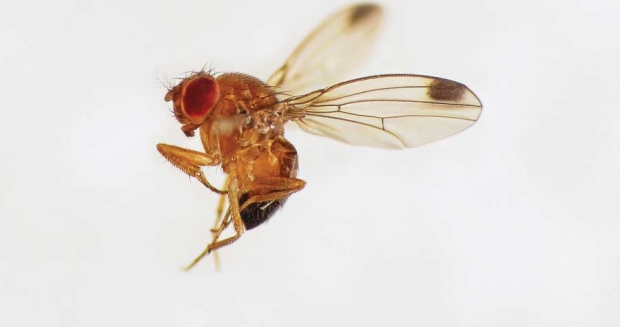
A male spotted-wing drosophila fly (Drosophila suzukii). (Courtesy Martin Cooper)
You’ve heard of spotted wing drosophila and the devastation it can cause to thin-skinned fruit, and you’ve seen the predictions that this pest may soon be coming to your area.
As a cherry grower, you do the prudent thing: set out traps and monitor your orchard for the tiny flies so you can mount a timely defense, if necessary.
As the season progresses, the traps remain empty, your fruit starts to color, and you think it’s clear sailing.
Then one of your traps catches a few flies. You quickly check the cherries and find they’re already infested.
What went wrong?
“If you’re only trapping your own orchard, you might be missing the big picture,” said David Haviland, entomology adviser for University of California Cooperative Extension in Kern County.
The “big picture” is that the flies were living and reproducing happily nearby in other plants, their numbers were building, and when your cherries developed to the stage that attracts SWD, the insects made a beeline for your orchard and descended en masse on your fruit.
The trigger for SWD is the assemblage of volatile chemicals that the cherries release as they mature, he said. “As soon as the flies can smell those volatiles, they will start to move into the cherry orchard.”
To truly stay on top of SWD, growers need to think outside the box, and in this case, that means outside the orchard in noncrop host plants, Haviland said. “The recommendation is to make sure you’re trapping in any area surrounding the orchard that might be harboring spotted wing drosophila.”
The culprit in Haviland’s area of the country, which includes part of California’s San Joaquin Valley, has only recently been identified.
“In 2010, spotted wing drosophila had not been recognized in my county, but we were looking for it because we had heard about it farther north in the state. So we encouraged growers to go and put out spotted wing drosophila traps,” he said.
Some of the participating cherry growers also managed citrus and thought oranges might be appealing to SWD. Their hunch was right. The traps in citrus caught flies.
This was an unexpected discovery, because SWD are unable to get through thick peels and have absolutely no impact on orange crops.
Further investigation revealed that the flies ignore both whole and rotting oranges, but they will take up residence in oranges if they can access the pulp through splits in the rind. Almost every tree will have a few split oranges, he said, and that’s enough to support SWD populations.
In the southern San Joaquin Valley, split oranges are now recognized as the primary reservoirs for SWD before they move into cherries, he said. “In our area, spotted wing drosophila is active all winter long, so it’s really in the citrus from November until about March, and then it moves over into the cherries in March and April as they start to get ripe.”
Other parts of the country will have different SWD reservoirs, Haviland noted. “It might be a riparian area with various host plants, or it might be a forest that’s around your orchard.”
Reviewing reservoirs
That’s exactly what researchers are finding, according to extension specialist Nikki Rothwell, coordinator of the Northwest Michigan Horticulture Research Center.
She presented information about SWD reservoirs during a talk at the December Great Lakes Fruit, Vegetable and Farm Market EXPO in Grand Rapids, Michigan.
She mentioned Cornell University research that described numerous noncrop hosts for adult SWD, including barberry, buckthorn, choke cherry, honeysuckle, laurel, mulberry, pokeweed and many others.
With that in mind, she and other Michigan extension personnel put together a trapping effort in northwestern Lower Michigan to determine the prevalence of adult and larval SWD in noncrop hosts adjacent to both tart and sweet cherry orchards.
This included mulberry and honeysuckle, which are common wild plants in the area.
They conducted weekly checks of 21 traps, harvested the fruit of those host plants as soon as it started to ripen, gathered any larvae in the fruit, and then reared the larvae so they could verify whether they were SWD.
The project confirmed that adult and larval SWD were indeed present in good numbers. “And we were getting a lot of larvae out of very few fruits,” she said, noting that they found their first 48 SWD larvae in just 60 fruits collected from a mulberry tree right next to a sweet cherry orchard.
These results indicate that SWD does build up in noncrop hosts and therefore can migrate to nearby commercial blocks and attack salable fruit, so growers should definitely be trapping for SWD in these potential reservoirs, she said.
“What’s your threshold for taking action? Here’s my threshold: one.” She added, “If you’re trapping and you catch one fly, I think that is the signal that you need to start protecting your fruit if it has lost that green color.”
Trapping in nonhost plants is a good strategy, Haviland agreed.
“We’ve had growers make the mistake of thinking that they don’t have any spotted wing drosophila because they don’t see them in their traps in the orchard. By the time they do find something in a trap, they’ve already got damage. That’s because they didn’t understand what was coming their way.”
Growers everywhere can learn from that lesson, he added.
“Every orchard is going to be different, and each pest-control advisor needs to think where flies might be coming from. If they trap those areas, that will give them a better indication of the threat that spotted wing drosophila poses to their cherries than if they only trap in their orchards.” •
– by Leslie Mertz






Leave A Comment